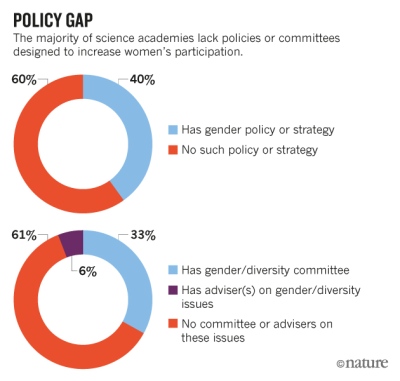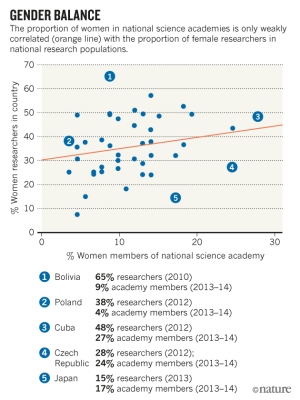TREND WATCH The first global survey of women’s representation at the highest level of academia shows that less than one-eighth of the members of science academies around the world are women.
Women made up just 12% of members among 69 academies that were surveyed in 2013–14, the Academy of Science of South Africa (ASSAf) and the InterAcademy Partnership (IAP) reported on 29 February. The Cuban Academy of Sciences had the highest proportion of women, at 27%, while the Tanzania Academy of Sciences and the Polish Academy of Sciences had the lowest levels, at 4%.
Women’s under-representation in academies matters because the organizations act as sources of both role models and science-policy advice, says Dorothy Ngila, who coordinated the study at ASSAf. “They should make sure their panels and reports are reflective of the diversity of our world,” she says. “You cannot provide advice to government using only half the team.”
The survey of members of the IAP, a global network of science academies, is the most comprehensive of its kind. Yet not all academies collect data on women's participation, says Ngila. "One of the glaring results is that academies are not consciously collecting this data," she says. In order to act on women's low representation within academies, the organisations must first report and analyse the relevant figures, she says.
Pushing for gender diversity
Nonetheless, the existing data provides some important insight, says Ngila. Academies in Central and South America, for example, boasted the largest proportion of women, accounting for 6 of the top 10 national academies by share of women members. These high numbers could, in part, be attributed to the fact that each of these academies has a member who is dedicated to gender issues, as part of the Women for Science programme of their parent body, the InterAmerican Network of Academies of Science. “There is an expectation that each academy reports on its trajectory, and this puts pressure on each to do more,” says Ngila.
An academy will only make progress if, like the Royal Society, it has a clear and stated intent to encourage more women nominations into the potential pool of candidates, says Athene Donald, a physicist at the University of Cambridge, UK, with an interest in gender diversity. Without such measures, "numbers won't go up fast", she says.
Being a member of a national academy would be expected to confer prestige, so if women are systematically less likely to be elected, they are also less likely to be asked to take on other important roles in policy and education, says Donald. “So the consequences reach far beyond the individual academies,” she adds.
Because figures in the survey refer to the makeup of an academy’s overall membership rather than its latest intake, the data might not reflect recent efforts to boost women’s representation, admits Ngila. In the United Kingdom, for example, only 6% of the Royal Society's members are women — but 20% of the 2015 intake were female.
Overall, the report found that only 40% of the academies surveyed had policies or strategies in place that explicitly mention the need for increased participation of women in the academy’s activities — a figure that Donald calls “disappointingly low”. Only one-third, meanwhile, had a committee that addressed gender or diversity issues, although this was a recommendation of a 2006 report by the InterAcademy Council, a consortium of national science academies that advises international bodies such as the United Nations.
The problem of under-representation also lies earlier in the system, says Donald, given that female representation becomes scarcer at each successive stage of academic seniority. The report’s authors compared women’s representation in academies with the proportion of female researchers in each country, and found only a weak positive correlation.
Inconsistencies in how the data were collected worldwide mean that it was not possible to compare the figures against the proportion of women professors in each country, says Ngila. This information could give a better idea of how many suitably qualified female candidates exist in each country. When Nature compiled these figures for European countries for which the data were available, however, there was little correlation between the percentage of women in a country’s professoriate and in its academy (results not shown).
Only one academy surveyed — the Science Council of Japan — had a higher proportion of women among its members than in the overall pool of researchers within the country.
By appointing more women members, academies can increase the visibility of women scientists and play a positive role in increasing their recruitment to science, says Curt Rice, the rector of the Oslo and Akershus University College of Applied Sciences, who is head of Norway's Committee on Gender Balance and Diversity in Research. Academies should not only do better in terms of reflecting women’s representation in science, but also paint a picture of how it should be, he adds. ”I would like to see them taking responsibility for being catalysts for change rather than agents of conservatism.”
- Journal name:
- Nature
- DOI:
- doi:10.1038/nature.2016.19465




Comments for this thread are now closed.